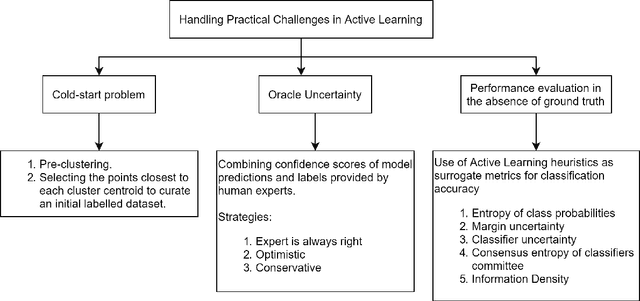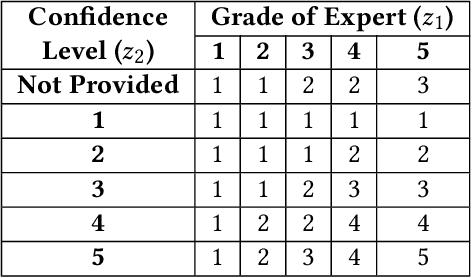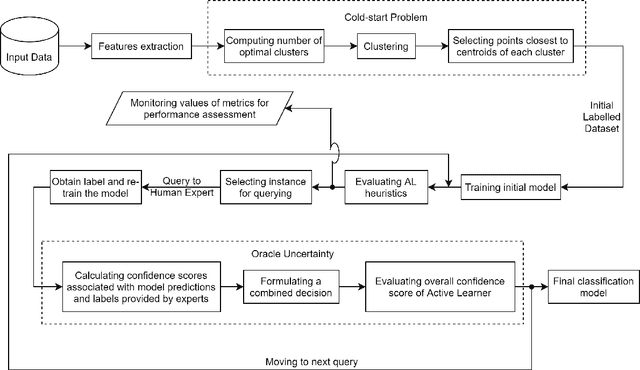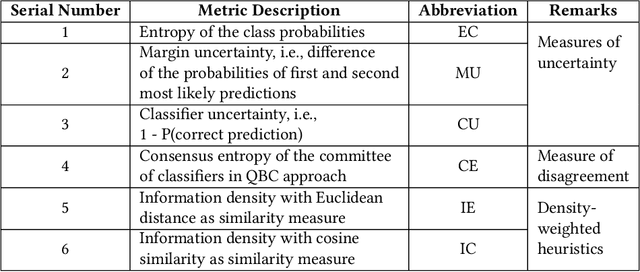Babji Srinivasan
Active Foundational Models for Fault Diagnosis of Electrical Motors
Nov 27, 2023Abstract:Fault detection and diagnosis of electrical motors are of utmost importance in ensuring the safe and reliable operation of several industrial systems. Detection and diagnosis of faults at the incipient stage allows corrective actions to be taken in order to reduce the severity of faults. The existing data-driven deep learning approaches for machine fault diagnosis rely extensively on huge amounts of labeled samples, where annotations are expensive and time-consuming. However, a major portion of unlabeled condition monitoring data is not exploited in the training process. To overcome this limitation, we propose a foundational model-based Active Learning framework that utilizes less amount of labeled samples, which are most informative and harnesses a large amount of available unlabeled data by effectively combining Active Learning and Contrastive Self-Supervised Learning techniques. It consists of a transformer network-based backbone model trained using an advanced nearest-neighbor contrastive self-supervised learning method. This approach empowers the backbone to learn improved representations of samples derived from raw, unlabeled vibration data. Subsequently, the backbone can undergo fine-tuning to address a range of downstream tasks, both within the same machines and across different machines. The effectiveness of the proposed methodology has been assessed through the fine-tuning of the backbone for multiple target tasks using three distinct machine-bearing fault datasets. The experimental evaluation demonstrates a superior performance as compared to existing state-of-the-art fault diagnosis methods with less amount of labeled data.
Foundational Models for Fault Diagnosis of Electrical Motors
Jul 31, 2023Abstract:A majority of recent advancements related to the fault diagnosis of electrical motors are based on the assumption that training and testing data are drawn from the same distribution. However, the data distribution can vary across different operating conditions during real-world operating scenarios of electrical motors. Consequently, this assumption limits the practical implementation of existing studies for fault diagnosis, as they rely on fully labelled training data spanning all operating conditions and assume a consistent distribution. This is because obtaining a large number of labelled samples for several machines across different fault cases and operating scenarios may be unfeasible. In order to overcome the aforementioned limitations, this work proposes a framework to develop a foundational model for fault diagnosis of electrical motors. It involves building a neural network-based backbone to learn high-level features using self-supervised learning, and then fine-tuning the backbone to achieve specific objectives. The primary advantage of such an approach is that the backbone can be fine-tuned to achieve a wide variety of target tasks using very less amount of training data as compared to traditional supervised learning methodologies. The empirical evaluation demonstrates the effectiveness of the proposed approach by obtaining more than 90\% classification accuracy by fine-tuning the backbone not only across different types of fault scenarios or operating conditions, but also across different machines. This illustrates the promising potential of the proposed approach for cross-machine fault diagnosis tasks in real-world applications.
Addressing practical challenges in Active Learning via a hybrid query strategy
Oct 07, 2021



Abstract:Active Learning (AL) is a powerful tool to address modern machine learning problems with significantly fewer labeled training instances. However, implementation of traditional AL methodologies in practical scenarios is accompanied by multiple challenges due to the inherent assumptions. There are several hindrances, such as unavailability of labels for the AL algorithm at the beginning; unreliable external source of labels during the querying process; or incompatible mechanisms to evaluate the performance of Active Learner. Inspired by these practical challenges, we present a hybrid query strategy-based AL framework that addresses three practical challenges simultaneously: cold-start, oracle uncertainty and performance evaluation of Active Learner in the absence of ground truth. While a pre-clustering approach is employed to address the cold-start problem, the uncertainty surrounding the expertise of labeler and confidence in the given labels is incorporated to handle oracle uncertainty. The heuristics obtained during the querying process serve as the fundamental premise for accessing the performance of Active Learner. The robustness of the proposed AL framework is evaluated across three different environments and industrial settings. The results demonstrate the capability of the proposed framework to tackle practical challenges during AL implementation in real-world scenarios.
 Add to Chrome
Add to Chrome Add to Firefox
Add to Firefox Add to Edge
Add to Edge